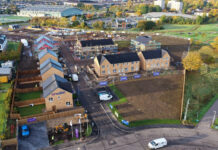
A West Dunbartonshire Council project to proactively tackle damp and mould in council properties has been shortlisted for an award.
The nomination in the excellence in health and wellbeing category at the Chartered Institute of Housing (Scotland) Scottish Housing Awards comes as the local authority marks the 1,000th install of environmental sensors in its properties.
The rollout began at the start of the year, with the technology on the sensors working by tracking data on air quality, humidity, and other environmental factors – with the council able to use the insight to plan any required works. The technology identifies problems with condensation, allowing the council to advise tenants at an early stage on how to manage this and avoid the potential for mould to develop.
This means work can be undertaken at the earliest possible stage, and allows the local authority to proactively plan for energy efficiency improvements while tackling issues including damp, mould and fuel poverty across the area.
The council added that the sensors can be retro-fitted to homes with ‘minimal disruption’ to tenants, and operate from a sim card so do not rely upon tenants’ internet connection. Furthermore, the sensors allow tenants to track the data about their own home through an app, with additional support and guidance from the council.
The devices have already been showing their value as, due to the information provided from one tenant’s environmental sensor, a costly repair was avoided. The property was flagged to the council because the environmental sensor was continually recording a high level of humidity but, besides a little condensation on windows, the tenant had nothing to report. There was no sign of mould or damp inside the home.
The building services officer was asked to attend and identified a broken down-pipe which meant an external wall was wet. This was driving up the humidity in the home and would have eventually presented as damp and mould.
Due to the early intervention, it was caught before there was any major and expensive damage to the property and the air quality improved for the tenant.
Convener of housing and communities, councillor Gurpreet Singh Johal, said, “This is a landmark moment for the council. Having fitted 1,000 environmental sensors within our homes and to be nominated for a Scottish Housing Award at the same time for this innovative project is fantastic news.
“These devices are a vital part of ensuring our housing stock remains at a high standard for tenants and avoids costly repairs further down the line.
“It also empowers tenants to take responsibility for air quality in their homes, giving them real-time information to act upon and we are reinforcing this messaging through regular correspondence with our tenants, stressing the difference the likes of opening windows can make to the air quality in homes.”







